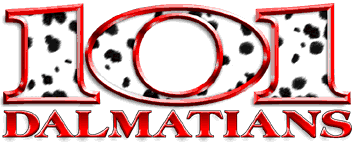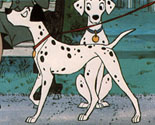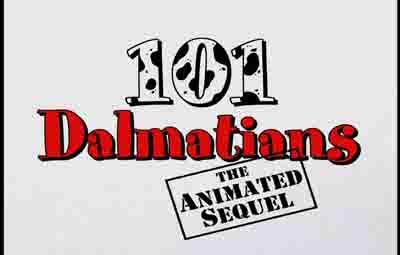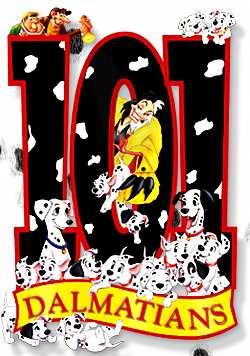

Directed by: Clyde Geronimi & Hamilton Luske
Written by: Bill Peet
Original Music by: George Bruns & Mel Leven

Released on: January 25, 1961
Running Time: 79 minutes
Budget: $3.6 million
Box-Office: $153 million in the U.S., $316.4 million worldwide
Pongo... Rod Taylor
Perdita... Cate Bauer & Lisa Daniels
Cruella de Vil & Miss Birdwell... Betty
Lou Gerson
Colonel Jasper Badun... J. Pat O'Malley
Rover... Barbara Luddy
![]() Rod Taylor, a rugged Australian actor, supplied the voice for Pongo, the
picture's hero. He is most famous for his leading role as Mitch Brenner
in Alfred Hitchcock's The Birds (1963).
Rod Taylor, a rugged Australian actor, supplied the voice for Pongo, the
picture's hero. He is most famous for his leading role as Mitch Brenner
in Alfred Hitchcock's The Birds (1963).
![]() Betty Lou Gerson [1914-1999] got the role of her life as Cruella de Vil.
She was also the narrator in Cinderella
(1950) and Nurse Andersone in the cult-movie The Fly (1958) starring
Vincent Price.
Betty Lou Gerson [1914-1999] got the role of her life as Cruella de Vil.
She was also the narrator in Cinderella
(1950) and Nurse Andersone in the cult-movie The Fly (1958) starring
Vincent Price.
![]() J. Pat O'Malley was responsible for four of the "character" voices and
a good deal of the authentic Cockney slang -he was also the voice of "Col.
Hathi" the Elephant in The Jungle Book.
J. Pat O'Malley was responsible for four of the "character" voices and
a good deal of the authentic Cockney slang -he was also the voice of "Col.
Hathi" the Elephant in The Jungle Book.

![]() During the "Twilight
Bark" sequence, you can see four canine stars from the Disney-Doggie film.
In order, you will see: Jock, Peg, Tramp
and Lady.
During the "Twilight
Bark" sequence, you can see four canine stars from the Disney-Doggie film.
In order, you will see: Jock, Peg, Tramp
and Lady.
![]() When Jasper gets
hit on the head with a club, he rolls his eyes and says "Whoa!...OW!" which
is the exact same line that Arthur's brother Wart would say 2 years later,
when he gets hit on the head in the kitchen scene of The
Sword in the Stone (1963)!
When Jasper gets
hit on the head with a club, he rolls his eyes and says "Whoa!...OW!" which
is the exact same line that Arthur's brother Wart would say 2 years later,
when he gets hit on the head in the kitchen scene of The
Sword in the Stone (1963)!
![]() This was the first
animated feature to gross over $10 million on initial release. The film
since grossed well over $200 million worldwide. Its 1985 release alone
earned $32.1 million!
This was the first
animated feature to gross over $10 million on initial release. The film
since grossed well over $200 million worldwide. Its 1985 release alone
earned $32.1 million!

![]() 101 Dalmatians is based on a successful British novel by Dodie Smith;
it was Oscar-Nominated for Best Adapted Score.
101 Dalmatians is based on a successful British novel by Dodie Smith;
it was Oscar-Nominated for Best Adapted Score.
![]() Several of the
characters from Lady and the Tramp (1955) can be seen in a pet shop window
during the twilight bark sequence.
Several of the
characters from Lady and the Tramp (1955) can be seen in a pet shop window
during the twilight bark sequence.
![]() At one point Jasper
and Horace's TV set features Disney's award-winning cartoon short Flowers
and Trees (1932).
At one point Jasper
and Horace's TV set features Disney's award-winning cartoon short Flowers
and Trees (1932).
![]() When the Baduns
are talking on the phone to Cruella, they are holding a newspaper. The
only headline on the front page (apart from the dognapping) is CARLSEN
SPEAKS, and a picture of a capsized ship. This helps us to date the story,
since the Carlsen in question is Kurt Carlsen, captain of the freighter
Flying Enterprise, which sank after a prolonged struggle in the Atlantic.
This was the media event of the year in 1952.
When the Baduns
are talking on the phone to Cruella, they are holding a newspaper. The
only headline on the front page (apart from the dognapping) is CARLSEN
SPEAKS, and a picture of a capsized ship. This helps us to date the story,
since the Carlsen in question is Kurt Carlsen, captain of the freighter
Flying Enterprise, which sank after a prolonged struggle in the Atlantic.
This was the media event of the year in 1952.
![]() Walt Disney did
not approve of the look of this picture: Ub Iwerks, whether he realized
it at the time or not, had a great impact on the future of Disney animation
with the invention of the use of the Xerox process to transfer animation
drawings to celluloid: the artists' drawings were transferred directly
to the cells (transparent overlays on which the characters are drawn),
and from them to the film. The laborious hand-inking of thousands
of cells was, therefore, no longer necessary.
Walt Disney did
not approve of the look of this picture: Ub Iwerks, whether he realized
it at the time or not, had a great impact on the future of Disney animation
with the invention of the use of the Xerox process to transfer animation
drawings to celluloid: the artists' drawings were transferred directly
to the cells (transparent overlays on which the characters are drawn),
and from them to the film. The laborious hand-inking of thousands
of cells was, therefore, no longer necessary.
 It
set the visual style of Disney animation (a scratchy, hard outline look)
for years until the technology advanced enough -with the production of
The
Rescuers (1977)- to allow a softer look. At first, it must
have seemed preposterous to even suggest that these images with thick,
black, scraggly lines could ever replace the refined, colorful lines of
all Disney animation up to that point. But, the animators appreciated
the vitality this medium would bring to their work.
It
set the visual style of Disney animation (a scratchy, hard outline look)
for years until the technology advanced enough -with the production of
The
Rescuers (1977)- to allow a softer look. At first, it must
have seemed preposterous to even suggest that these images with thick,
black, scraggly lines could ever replace the refined, colorful lines of
all Disney animation up to that point. But, the animators appreciated
the vitality this medium would bring to their work.
Now then, with this thick black line dominating the animation, something had to be done to the world which the animation would inhabit. It wouldn't work to place these Xeroxed characters in a lush, colorful, painted background. So, designer Ken Anderson created a look for the backgrounds and props which would blend beautifully with this modern animation style. After painting the backgrounds with flat shapes, Anderson carefully inked-in all of the detail the background needed to present. This way, the important parts of the background stand out and blend beautifully with the stylized characters.
![]() During the course
of filming, Disney used more than 200 dogs to film the basic litter of
15 Dalmatian puppies. The pups, all roughly eight weeks old, were brought
to the set in a relay system. Most were filmed for only one or two weeks
before they had grown too big and had to be replaced by younger ones. With
all those dogs shuttling in and out during filming, how did Disney ensure
continuity? They hired a makeup artist and dog breeder to paint on spots
using vegetable dye. Thus, the newcomers always matched the pups they replaced!
During the course
of filming, Disney used more than 200 dogs to film the basic litter of
15 Dalmatian puppies. The pups, all roughly eight weeks old, were brought
to the set in a relay system. Most were filmed for only one or two weeks
before they had grown too big and had to be replaced by younger ones. With
all those dogs shuttling in and out during filming, how did Disney ensure
continuity? They hired a makeup artist and dog breeder to paint on spots
using vegetable dye. Thus, the newcomers always matched the pups they replaced!

![]() The picture
was released in 1961 after nearly three years in production, at a total
cost of $4 million. It is possible that the 150 studio artists labored
so long because of the unique nature of the characters. Dalmatians
wear white coats with black spots, and, according to Studio statistics,
the creation of 101 of them entailed the laborious painting of a total
of 6,469,952 spots! Pongo, the leading canine character, wears 72
black spots while Perdita, his mate, sports a coat with but 68; each of
the 99 puppies wears 32.
The picture
was released in 1961 after nearly three years in production, at a total
cost of $4 million. It is possible that the 150 studio artists labored
so long because of the unique nature of the characters. Dalmatians
wear white coats with black spots, and, according to Studio statistics,
the creation of 101 of them entailed the laborious painting of a total
of 6,469,952 spots! Pongo, the leading canine character, wears 72
black spots while Perdita, his mate, sports a coat with but 68; each of
the 99 puppies wears 32.
![]() One of the most
impressive comic effects was the smoke emanating in curls and clouds from
the villainess Cruella De Vil's ever-present cigarette. Waved about
in a slinky long holder, the cigarette created its own calligraphy of evil.
The special effects technicians used so much smoke that, if it were compressed
into a single cloud, they estimate it would blanket a city of one hundred
thousand souls.
One of the most
impressive comic effects was the smoke emanating in curls and clouds from
the villainess Cruella De Vil's ever-present cigarette. Waved about
in a slinky long holder, the cigarette created its own calligraphy of evil.
The special effects technicians used so much smoke that, if it were compressed
into a single cloud, they estimate it would blanket a city of one hundred
thousand souls.
|
||||||||||||